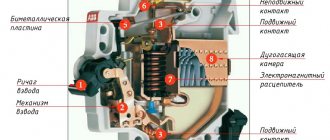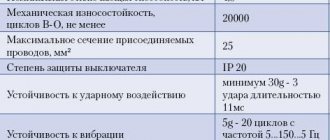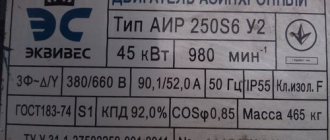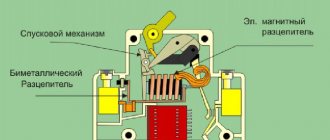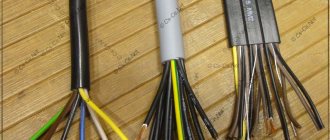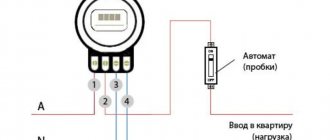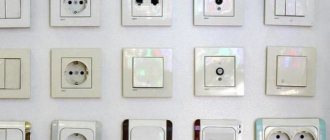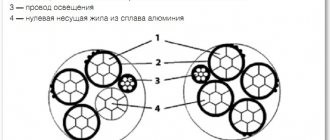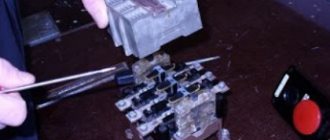IIITOIIOP68 › Blog › Slot machines - what's what and why.
Good day!
Today we will look at circuit breakers
A little theory. Why are they even needed? But they are needed precisely to protect the network and devices only from short circuits and overloads. They do not perform any other protective functions. Circuit breakers (hereinafter referred to as AB) have several characteristics
Trip curve - B, C, D
The tripping curve is the short circuit rating required for tripping. The graph clearly shows that the shutdown curve B is 3-5 ratings, C is 5-10 ratings, D is 10-20 ratings. What are these curves for? Shutdown curve B - used in new buildings and in houses where there is low voltage. If the C16 circuit breaker needs at least 80 amperes to disconnect due to a short circuit, then B is only 48 amperes. Therefore, if the wiring is old or weak, or the voltage is low, then the best option is a machine with curve B. Shutdown curve C - used everywhere from domestic to industrial use. The most common curve. There is basically nothing to describe here: 5-10 denominations are the norm. Shutdown curve D - is mainly used for reactive loads - devices containing a winding (motors, large groups of lamps with chokes, etc.). With such a curve, machines are installed in access distribution boards. If a machine with curve C and a rating of 16 amperes needs 80 amperes for short-circuit shutdown, then the same machine with curve D needs 160 amperes for short-circuit.
This is how we came to the term AV selectivity. The selectivity of circuit breakers is the selection of devices in one system in such a way that in the event of damage or an emergency in any part of the electrical system, the shutdown is carried out by one circuit breaker, which is located closest to the point of damage on the line and other circuit breakers do not worked. That is, if a malfunction or accident occurs in the area of the socket, then only the circuit breaker of the socket group of this room is turned off, and the machines located between the meter and this machine are not turned off.
2. The AV also has a maximum short-circuit breaking current - this is the maximum current at which the circuit breaker’s breaking capacity will be maintained. It is designated by the numbers 4500, 6000 or 4.5 kA, 6 kA, and so on. If our machine has a maximum breaking capacity of 4500 A = 4.5 kA, then a short-circuit current of 4500 amperes will most likely ruin it. But at home or in an apartment it is practically impossible to obtain such a current through a short circuit. Therefore, there is no point in setting more than 4.5 kA for houses and apartments. For offices, non-residential premises and in production, 6kA circuit breakers are used in full - there are reactive loads and short circuits are possible.
3. And there is also a bimetallic plate. It is needed to turn off the AV when overloaded. Let's say: there is a 16-amp circuit breaker, a maximum power of 3520 Watts, the rating of the thermal release along curve C is on average 1.45 of the rating - 23.2 amperes or 5104 Watts! But this does not mean that you need to overload the line by 1.45 times! If there is such an overload, the machine will work almost immediately! But if you start from 4000 Watts, then there will be a delay of 5-10 minutes. after which the AB will work.
4.They also differ in modules. 1 module = 17.5 mm - German DIN standard. Consequently, machines come in 1, 2, 3 and 4 modular types.
THERE ARE NO 2- and 3-PHASE AUTOMATIC MACHINES!
Now let's look at the machine itself in analysis
These are the guts of a Chinese machine gun! The numbers indicate its main components: 1. Connection terminal (located both above and below the AB) 2. Arc chamber - necessary for dividing a large arc (during short-circuit tripping) into smaller arcs that will not damage the AB. 3. Bimetallic plate. 4. Electromagnetic release. 5. Switch mechanism.
Well, now let’s look at AVs from different manufacturers. They are sorted by quality from good to bad.
1. ABB S200 - purebred Germans! A professional series with high quality, the price tag is high, but worth it. There have not yet been any complaints that these machines did not work. 6kA. This series has the ability to connect all sorts of additional accessories. equipment relay max/min voltage, status contact and others. A separate compartment has been made for connecting the comb/fork bus.
2. ABB SH200 - also purebred Germans. The series for the home is already 4.5 kA. More simple, but the highest quality.
3. Schneider Electric Acti-9 series iC9 or iK9 - German French. The quality is slightly lower than ABB, but still there. iС9 and iК9 differ in the same thing - a professional and simple series.
4. Legrand DX-3 and DX-3 are French, assembled in Poland or Bulgaria (oh whore!), the quality is correspondingly lower. The price tag is mainly for the brand. DX-3 is a professional Polish series, TX-3 is a simple Bulgarian series.
5. Schneider Electric Domovoy - a budget series from Schneider. Collected in Romania, the quality is slightly lower than Legrand. The price is also lower.
6. KEAZ - OptiDin - Kursk! Our! The quality, according to the manufacturer, is high, but not tested. Assembled by hand, defect rate is 0.1%. the price tag is acceptable.
7. IEK - a fucking persecution of Chinese assembled in Russia - I personally saw how they burn! Very beautiful))) The machines were stolen from Schneider (when they were still Merlin Gerin) about 15-20 years ago. They are still produced using the same technology (Schneider has long surpassed them in technology and quality). Suitable for temporary work (so that builders/finishers/renovators don’t steal it too late) and for budget organizations. But recently, oddly enough, the quality has begun to improve.
8. TDM - separated from IEK and created their own factory with blackjack and whores! The drawings, technologies and all the bells and whistles are the same, only TDM! The quality is below IEKa.
9. There are also all sorts of ASD, EKF, DeKraft and others, whose quality is very questionable. Also copied from the ancient developments of Merlin Gerin, but clumsily and without modifications, because of this they often burn and have a short service life.
Cable cross-section for machine s16
In residential buildings, as a rule, a single-phase network is used. Therefore, wiring is chosen with 2 or 3 cores. Their cross-sectional diameter must correspond to the installed 16-amp electric machine. The maximum permissible diameter is 25 square meters. mm, but the indicator also depends on the metal of which the cable is composed. Here is their comparative characteristics:
Metal in wires
| Criterion | Aluminum wire | Copper wire |
| Cross section | From 2.5 sq. mm | From 0.35 sq. mm |
| Current conductivity | Up to 3 kW at minimum cross-section | The figure is approximately 1.6 times higher |
| Life time | 15-20 years | About 50 years |
| Strength | The wire breaks easily when bent | Due to the plasticity of the metal, the wiring can be laid at any angle. The fragility index for the same cross-section is 2-3 times lower. |
| Ease of installation | To power a modern outlet, you need a wire with a cross-section of 4 square meters. mm. The built-in terminals have a tolerance of 3 mm. That is, a connection with a nominal value of 16A is excluded. | For a similar task (16A socket), a cable with a core cross-section of 1.5-2.5 square meters is required. mm. That is, there are no difficulties during installation. |
| Oxidation | The area with missing insulation quickly oxidizes. The resistance provided by the film reduces the permissible load on the contacts. Therefore, a special quartz-vaseline paste is used. | Patina conducts current well, so it does not affect the resistance of joints. |
You might be interested in Three-phase circuit breaker c25
Terminals in socket
Despite the noticeable difference in the cost of materials (aluminum wiring is 2-3 times cheaper), most cables are laid using copper cable. When choosing the cross-section of the cores, they rely on the nature of the machine and the method of placing the wires.
For a 16A protective device, the copper core must have a cross-section of 2.5 square meters. mm. This corresponds to its maximum voltage of 21A in a walled position, 30A in an open position (it is in contact with the external environment, which means it easily gives off heat when heated).
If you take a wire with a cross section of 1.5 sq. mm, then within an hour it will overheat and fail. This is justified by the maximum permissible current of 18 A.
Installation inside and outside walls
Are circuit breakers Type B or Type C?
The time-current characteristic means the dependence of the response time on the ratio of the current flowing through the switch I to the rated current of the circuit breaker In. Obviously, when a safety hazard occurs, the circuit breaker must operate quickly. But is fast response always good?
Let's imagine an ideal circuit breaker should operate instantly when the rated current is slightly exceeded. But, if such a switch could be created, it would be completely useless due to constant false alarms. When turning on or off any electrical device in the network, extra switching currents inevitably arise. The current when starting an electric motor is much higher than in steady state. When the power supply is turned on, there is a significant surge in current consumption due to the charging process of the smoothing capacitors. In many modern devices, switching the load on and off constantly occurs during operation. If the delay time were zero, the switch would trip whenever the load switched. At the same time, at very high currents, for safety reasons, de-energize the electricity consumer almost instantly. This contradiction in modern circuit breakers is resolved by using two types of releases simultaneously - thermal and electromagnetic. Thermal releases operate if the current flowing through the circuit breaker exceeds 1.45 In for a long period of time. They prevent overheating of electrical wires, which leads to the destruction of insulation. Electromagnetic releases protect against short circuits. They operate almost instantly at a current strength that exceeds In by 3 to 20 times, depending on the type of time-current characteristic. This parameter is called instantaneous tripping current. Classification of circuit breakers according to the time-current characteristic According to GOST R 50345-2010, circuit breakers for household and similar applications (small office, small production) are divided, depending on the time-current characteristic, into types B, C and D. There are also some other types of time-current characteristics, also designated by letters, for example, A. But they are either taken out of use due to obsolescence, or are intended for highly specialized applications. GOST R 50345-2010 defines circuit breakers with a time-current characteristic of type B as having an instantaneous tripping current of over 3In to 5In inclusive, type C - over 5In up to 10In inclusive, type D - over 10In up to 20In inclusive. In this case, instantaneous tripping means breaking the power circuit in less than 0.1 s. Also, the response time under certain conditions may be related to the rated current of the machine, and not to its type. For example, with a long-term current of up to 1.13 In inclusive, the circuit breaker should not trip. When a current of 1.45 In is applied, tripping should occur in less than 1 hour with a rated current of the machine up to 63 A inclusive, and less than 2 hours with a rated current of the machine more than 63 A. When a current of 2.55 In flows through the machine, the operation time is from 1 up to 60 s at a rated current up to 32 A inclusive and from 1 to 120 s at a rated current over 32 A. Please note that for a current of 2.55 In, not only the maximum, but also the minimum response time is standardized. Typical time-current characteristics of circuit breakers of types B, C and D Type D is used extremely rarely. Basically, circuit breakers with this characteristic are installed where very powerful electric motors are used. For example, in detached cottages, where there are powerful water pumps and centralized air conditioning systems. Sometimes automata with time-current characteristic D are used as input circuits to ensure selectivity. In the vast majority of projects, you have to choose between time-current characteristics B and C. Time-current characteristic type B is recommended for electrical appliances that represent a load with a predominantly active component. These can be incandescent lamps, all kinds of heaters, electric ovens for cooking. Also, devices that are connected to a type B circuit breaker should not have high inrush currents. According to established practice, fluorescent lamps are often connected to type B circuit breakers.
Time-current characteristic type C is recommended for electrical appliances that represent a load with a pronounced reactive or nonlinear component, or that have significant inrush currents. These include LED lamps and luminaires, all kinds of household devices with electric motors, equipment with switching power supplies, and computer equipment.
The best option is to use a circuit breaker with a special time-current characteristic for this type of load. But this can be practically realized if the load is connected to the circuit breaker via a permanent connection, or the socket is located in such a way that only one type of load can be connected to it. But in reality, the more common option is when there is an outlet into which a wide variety of devices can be plugged in. Therefore, it is necessary to select circuit breakers of a type that would best suit the varied load. Already existing wiring About 20 years ago, devices with switching power supplies were still rare, and LED lamps and luminaires were not mass-produced at all. Therefore, in the overwhelming majority of residential premises and offices, type B circuit breakers were used. When choosing the wiring cross-section, the first thing to consider is that even at the farthest end, in the event of a short circuit, the current is sufficient to trip the circuit breaker. This requirement often results in larger wiring sizes than required for a given maximum load power. Since machines with a time-current characteristic of type B operate at currents of 3In - 5In, thanks to their use it is possible to slightly reduce the wiring cross-section. In modern conditions, type B machines can exhibit frequent false positives. The most typical example from real practice is the replacement of fluorescent lamps in a room with LED ones. The average current consumption decreases several times, but previously installed circuit breakers that could easily withstand the load of fluorescent lamps begin to trip when LED lighting is turned on due to significantly higher inrush currents. For LED lighting, it is preferable to use the time-current characteristic of type C. The problem is usually “cured” by replacing type B circuit breakers with type C circuit breakers. But you cannot simply remove some circuit breakers in the panel and install others in their place - a situation may arise that in the event of a short circuit, a type circuit breaker C won't work. It is necessary to examine the condition of the wiring, find its farthest end and determine the short circuit resistance. Better yet, in addition to inspecting the condition of the wiring, find documentation for the project and conduct a comprehensive analysis of it. Naturally, all this should be done by an experienced, qualified specialist. In the event that replacing type B machines with type C machines is not possible for safety reasons, it will be necessary to limit the use of devices that cause false protection. Or replace the wiring. New wiring When creating new projects, you can initially include the use of type C circuit breakers. In this case, the appropriate wiring cross-section is selected so that the circuit breaker reliably operates in the event of a short circuit even at its farthest end.
Some manufacturers only supply machines with type C characteristics for free sale, and if type B characteristics are needed, then such a machine is only available for pre-order. Or they leave the opportunity to choose the time-current characteristic only in the most expensive product lines. Easy9 circuit breakers manufactured by Schneider Electric have certain advantages in this sense. The products of this line have an optimal price/quality ratio. Moreover, it has circuit breakers of types B and C with ratings from 6 to 63 A (1-4 poles). Moreover, type B can actually be purchased without pre-order. However, in our time, we need circuit breakers not only of type C, but also of type B, which will be discussed below.
Circuit breakers of the Easy9 line from Schneider Electric are available to consumers in options with time-current characteristics of types B and C
The wiring in an apartment or cottage may be new, but the building itself is located in an area with old, worn-out infrastructure. In this case, the use of type C machines will lead to problems with energy supply not only for you, but also for your neighbors. That is why, in any case, it is highly advisable to consult your electricity supplier about the acceptable types of time-current characteristics of circuit breakers. For a stationary electric water heater, it is preferable to use the time-current characteristic of type B, even if you have new wiring. Current regulations require the installation of separate circuit breakers for stationary water heaters, as well as powerful building electrical heating systems. Since in this case one circuit breaker serves only one device, and the load is exclusively active, it makes sense to use a type B circuit breaker, even if you have installed new wiring. As a result, safety is significantly improved. It should be noted that in modern high-quality household appliances, thanks to the use of special technologies, inrush currents are much lower than they were before, even if a switching power supply is used. Therefore, if you have equipped your apartment or cottage with only modern equipment, you can opt for type B circuit breakers. At the same time, you can increase the reliability of the power supply by implementing the principle of selective shutdown. It lies in the fact that due to a time delay in the operation of a higher-level circuit breaker relative to a lower one, a power outage throughout the cottage or throughout the entire apartment is prevented. The most economical way to implement selective protection is to install a type C input circuit breaker, and use type B circuit breakers as downstream ones.
The choice of time-current characteristics of a circuit breaker should be dictated only by objective conditions. The fact that Type C machines are now used much more often than Type B machines that dominated in the past does not mean that Type C is "better" or "more advanced". These are simply two different types for different conditions, but the technological level of their performance is the same, which is confirmed, for example, by the range of low-cost modular devices in the Easy9 line from Schneider Electric. Regardless of whether the circuit breaker has a time-current characteristic type B or C, the famous Schneider Electric quality is guaranteed.
When choosing a circuit breaker, the main parameter is the rated current. But, along with it, there is also such a parameter as the time-current characteristic.
Changing the release characteristics of automatic machines
As mentioned at the beginning of the article, all characteristics of safety circuit breakers are given at an ambient temperature of 30 degrees Celsius. In order to find out the response time of mechanical switches at other temperatures, the following correction factors should be taken into account:
1.Kt – temperature coefficient of ambient air. You can analyze its values in the graph below. The higher the air temperature, the lower the value of this coefficient, which means the rated current of the switch, that is, its load capacity, decreases. Or, in other words, the colder it is, the lower the load capacity. For this reason, in hot rooms it is possible for the circuit breakers to operate even without an increase in load.
2.Kn – coefficient for taking into account the number of machines installed in a row. When several circuit breakers are installed in one row, they transfer part of their heat to the remaining switches. The graph below shows the dependence of heat convection on the number of machines. The more devices in a row, the less their load capacity.
In order to calculate the electric current, in accordance with the ambient temperature, you need to multiply the rated current of the mechanical switch by the above coefficients.
Now consider an example of using coefficients in practice. Let's say the distribution panel is installed on the street and 4 machines are connected to it:
- input machine type VA 47-29 S40 – 1 piece;
- group automatic machine type VA 47-20 C16 – 3 pieces.
The ambient temperature is minus 10 degrees Celsius.
We find correction factors for the VA 47-29 C16 machine gun:
1.Kt=1.1.
2.Kn=0.82.
We calculate the rated current:
In=16*1.1*0.82=14.43 Ampere.
Therefore, to determine the maximum shutdown time of a type C circuit breaker, you need to use not the ratio I/In (I/16), but I/In* (I/14.43).
Differences in the protective characteristics of C, B and D circuit breakers, areas of application of the circuit breakers
We supply BA47‑29 circuit breakers with rated currents from 0.5 to 63 amperes with protective characteristics B, C or D.
Introduction
Modular circuit breakers are used:
- to protect networks: from short circuits - an electromagnetic release is built in for this purpose;
- from overloads - a thermal release is built in for this purpose;
A thermal and electromagnetic release is installed in each pole of the machine and together they are called a combined release. Characteristic C, B or D determines the strength of the short-circuit current at which instantaneous protective operation will occur, and therefore the places where the machine with a specific characteristic will be used. The operation is caused by an electromagnetic release. On the left is a photograph of VM63 modular switches with an analysis of the inscriptions (“what is what”).
Differences between circuit breakers with characteristics B, C and D
| Type of protective characteristic | Instant shutdown in case of short circuit out of range | Preferred Circuit Breaker Application | Loads |
| B | (3-5)In | protection: - long cables; — networks with electric heating devices (stove, boiler); — low-power networks:
| resistive |
| C | (5-10)In | protection: — lighting; — sockets; — household electrical appliances. | resistive, inductive with low inrush current |
| D | (10-50)In | protection: - electric motors (washing machines, water pumps); — low-voltage transformers; - discharge lamps. | inductive with high starting current |
Values removed from table 2 on page 11 of the standard for modular circuit breakers GOST 50345‑99 (link below). where In is the rated current of the circuit breaker. Examples:
- A circuit breaker with a rated current In = 6 amperes with characteristic B: will not trip* with a short circuit of 18 amperes (3·In), but will switch off instantly with a short circuit of 30 amperes (5·In) and above.
- A circuit breaker with a rated current In = 16 amperes with characteristic C: will not trip* with a short circuit of 80 amperes (5·In), but will switch off instantly with a short circuit of 160 amperes (10·In) and above.
- A circuit breaker with a rated current In = 50 amperes with characteristic D: will not trip* with a short circuit of 500 amperes (10·In), but will turn off instantly with a short circuit of 2500 amperes (50·In) and above.
*By the words “will not work” we mean will not work under the influence of an instantaneous electromagnetic release. But there is a thermal release that will heat up within a few seconds and turn off the network.
At the same time, the standard does not indicate how the switch will behave in the range itself (the error is included). Tests are carried out only in boundary positions (according to table 6 on page 19 of the GOST 50345‑99 standard):
- lower limit (3, 5 and 10 from In, respectively) – shutdown does not occur within 0.1 seconds;
- upper limit (5, 10 and 50 from In, respectively) – protective operation occurs within 0.1 seconds.
Circuit breaker characteristic B
Switches with characteristic B are used for protection:
- long cable lines;
- circuits with a heating element (heating element, electric oven, boiler);
- secondary circuits or networks with high resistance and low current (which causes low-level short-circuit currents): alarms;
- management;
- measurements.
Characteristic C of circuit breaker
Automatic machines with characteristic C are used everywhere: in domestic and office premises, at industrial facilities. They help protect:
- apartment and office sockets;
- lighting in the kitchen, bedrooms; in the bathroom, in the office, in the workplace;
- individual consumers (without powerful engines).
Purpose and types of machines
A circuit breaker is a safety device that cuts off the flow of current into the wiring in the event of an overload in the network and/or a short circuit.
This happens using a release. It comes in three types, on which the direct purpose of the switch depends. The thermal one is used to protect against overloads in the network; it is a bimetallic plate of a thermal relay. When the rated current is exceeded, it heats up, expands and bends, pushing the lever, which breaks the connection. The second type is electromagnetic. It is a system of coil, core and spring designed to provide short circuit protection. With a sharp increase in the current passing through the coil, the magnetic field changes, this in turn changes the position of the core, leading to compression of the spring and activation of the lever.
There is also a universal option - combined. It combines both of the mechanisms described above, protecting simultaneously from overloads and power surges.
By design, circuit breakers are divided into several types depending on the current strength for which they are designed:
- air - from 800 to 6300 A;
- in a molded case - from 10 to 2500 A;
- modular - from 0.5 to 125 A.
There is a division of automatic switches according to operation time. This is a characteristic that determines the release speed. Depending on its meaning, three types are again distinguished. The first is normal (0.02-0.1 s), followed by selective (up to 1 s) and fast-acting with a current-limiting effect (up to 0.05 s). The latter are especially durable and effective. Such a machine is triggered just before the overload, until the current increases strongly. To select this parameter, it is necessary to take into account the strength of overloads that may occur and their frequency. The higher they are and the more often they occur, the faster the device should respond to them.
What should a machine gun protect against?
First of all, the machine is designed to protect wiring from fire and destruction. As a rule, the automatic device does not protect electrical appliances, nor does it protect a person from electric shock - this function is performed by a differential switch (RCD in popular usage) or a differential circuit breaker (combines an RCD and a circuit breaker). So, since it protects the wiring, it means that the rating should not be overestimated to eliminate unnecessary operations - if the wiring is in danger of fire or destruction, there should be no talk of any power reserve! Simple wisdom: if you want reliable protection and a minimum of alarms, increase the cross-section of the conductive wires, within reasonable limits, of course.
There is a misconception that if the wiring can withstand a current equal to the rating of the machine, then everything is in order and a fire will never happen. This is far from true. In the last article, we superficially touched on the topic of wiring and machines, but most importantly we got acquainted with the table, which shows the currents for various wire sections. Now we will use this table and see which wires with the rating of which machine can be protected.

